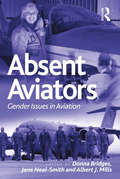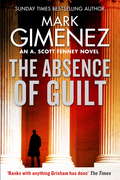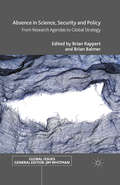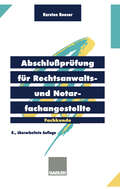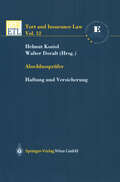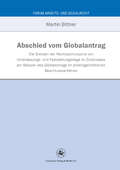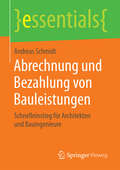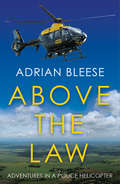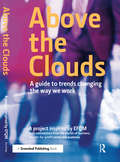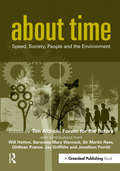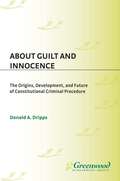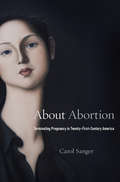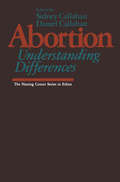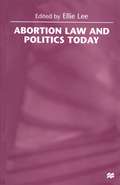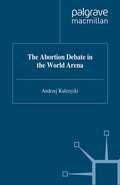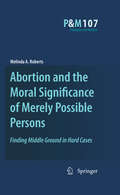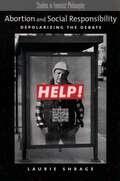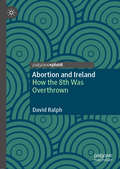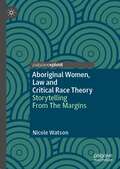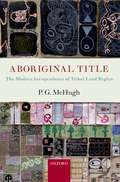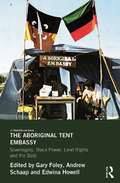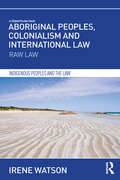- Table View
- List View
Absent Aviators: Gender Issues in Aviation
by Albert Mills Jane Neal-Smith Donna BridgesThe objective of this book is to present a number of related chapters on the subject of gender issues in the workplace of the aviation industry. More specifically, the chapters address the continuing shortfall in the number of women pilots in both civilian and military aviation. Considerable research has been carried out on gender issues in the workplace and, for example, women represent about 10% of employees in engineering. This example is often used to show that the consequences of gender discrimination are embedded and difficult to overcome in masculine-dominated occupations. However, women represent only 5-6% of the profession of pilot. Clearly there are many factors which mitigate women seeking to become pilots. The chapters within this volume raise both theoretical and practical issues, endeavouring to address the imbalance of women pilots in this occupation. Absent Aviators consolidates a diverse range of issues from a number of authors from Australia, Austria, the United States, Canada, South Africa and the United Kingdom. Each of the chapters is research-based and aims to present a broad picture of gender issues in aviation, gendered workplaces and sociology, underpinned by sound theoretical perspectives and methodologies. One chapter additionally raises issues on the historical exclusion of race from an airline. The book will prove to be a valuable contribution to the debates on women in masculine-oriented occupations and a practical guide for the aviation industry to help overcome the looming shortfall of pilots. It is also hoped it will directly encourage young women to identify and overcome the barriers to becoming a civilian or military pilot.
The Absence of Guilt (A. Scott Fenney)
by Mark GimenezMark Gimenez, author the massive international bestseller The Colour of Law, is back, as superstar lawyer Scott A. Fenney takes the stand for an impossible case. An ISIS attack on America is narrowly averted when the FBI uncovers a plot to detonate a weapon of mass destruction in Dallas, Texas during the Super Bowl.A federal grand jury indicts twenty-four co-conspirators, including Omar al Mustafa, a notorious and charismatic Muslim cleric known for his incendiary anti-American diatribes on YouTube and Fox News. His arrest is greeted with cheers around the world and relief at home. The President goes on national television and proclaims: 'We won!'There is only one problem: there is no evidence against Mustafa. That problem falls to the presiding judge, newly appointed U.S. District Judge A. Scott Fenney.If Mustafa is innocent, Scott must set the most dangerous man in Dallas free, with no idea who is really guilty.And with just three weeks before the attack is due . . .
Absence in Science, Security and Policy: From Research Agendas to Global Strategy (Global Issues)
by Brian Rappert Brian BalmerThis book explores the absent and missing in debates about science and security. Through varied case studies, including biological and chemical weapons control, science journalism, nanotechnology research and neuroethics, the contributors explore how matters become absent, ignored or forgotten and the implications for ethics, policy and society.The chapter 'Sensing Absence: How to See What Isn't There in the Study of Science and Security' is open access under a CC BY 4.0 license via link.springer.com.
Abschlußprüfung für Rechtsanwalts- und Notarfachangestellte: Fachkunde
by Karsten RoeserWarum sind die Anforderungen gerade in Fachkunde besonders hoch? In Fachkunde werden noch am unmittelbarsten die Themen angesprochen, die für die Büropraxis wichtig sind, so die Anfertigung von Schriftsätzen, die Erstellung von Kostenrechnungen und die Durchführung der Zwangsvollstreckung. Diesen erhöhten beruflichen Anforderungen versucht der Lehrplan durch sehr zahl reiche und komplexe Lerninhalte gerecht zu werden. Für diejenigen, die "nur" den Ausbildungsberuf "Rechtsanwaltsfachangestellte/r" oder "Notarfachangestellte/r" anstreben, fällt nur ein geringer Teil der Lerninhalte weg, und zwar der, der umge rechnet etwa einem halben Ausbildungsjahr entspricht. Berücksichtigt man, daß auch die übrigen Fächer sehr stark mit Stoff befrachtet sind, so wird ohne weiteres einsichtig, daß man in der Prüfung nicht auf allen Gebieten fit sein kann. Vielmehr ist es erforderlich, sich auf die prüfungsbedeutsamen wesentlichen 'Teilgebiete zu beschränken. Warum ist die Prüfung in Fachkunde besonders wichtig? Zwar werden Sie in den verschiedensten Fächern geprüft, doch als Ergebnis bekom men Sie lediglich eine Gesamtnote. Diese errechnet sich aus den einzelnen Prüfungs ergebnissen im Rahmen der schriftlichen und mündlichen Prüfungen in den einzel nen Fächern. Da ist es nun wichtig zu wissen, daß nicht jedes Fach gleichberechtigt ist. Die Endnote errechnet sich nämlich nach einem komplizierten Schlüssel, in dem einzelne Fächer sehr verschieden gewichtet werden. Ablauf und Inhalt der Prüfungen richten sich nach der für Sie zuständigen Ausbil dungsordnung vom 23. November 1987 (BGBl. I S. 2392), die im schönen Amts deutsch ReNoPatAusbV heißt und mit Wirkung zum 1. August 1995 geändert wurde, sowie nach der von Ihrer örtlich zuständigen Kammer erlassenen Prüfungsordnung.
Abschlussprüfer: Haftung und Versicherung (Tort and Insurance Law #12)
by R. Bertl H. Koziol A. Biegl U. Magnus W. Doralt K. Oliphant C. Fröhlich A. ScarsoSpektakuläre Unternehmenskrisen der jüngeren Vergangenheit haben national und international Diskussionen hinsichtlich einer strengeren Haftung für Abschlussprüfer ausgelöst. Vor diesem Hintergrund stellt die vorliegende Arbeit die Haftungssituation in Österreich, Deutschland, Italien und England umfassend und unter Berücksichtigung der aktuellen Rechtsprechung dar. Ausgehend vom Ablauf von Jahresabschlussprüfungen und anhand von Fallstudien werden die zentralen mit der Haftung in Zusammenhang stehenden Fragen aufgearbeitet: Wann und für welche Schäden wird gehaftet? Wann kommt es zur direkten Haftung gegenüber den geprüften Unternehmen, aber auch gegenüber Gläubigern und Anlegern – und wie ist diese Haftung begrenzt? Experten aus Wissenschaft und Praxis bieten den Lesern einen profunden Einstieg in diese Problembereiche, wobei Fragen der Haftpflichtversicherung in einem eigenen Beitrag erörtert werden.
Abschied vom Globalantrag: An den Grenzen der Rechtsschutzzone von Unterlassungs- und Feststellungsklage im Zivilprozess am Beispiel des Globalantrags im arbeitsgerichtlichen Beschlussverfahren (Forum Arbeits- und Sozialrecht #39)
by Martin BittnerIm Zivilprozess geht es den Parteien vielfach nicht nur um die gerichtliche Entscheidung des Einzelfalls. Von dem Urteil erhoffen sie sich auch eine verbindliche Orientierungshilfe für die Zukunft. Zu diesem Zweck wird ein „Globalantrag“ zum Gegenstand von Unterlassungs- und Feststellungsklagen gemacht. Die Gerichte werden auf diesem Wege um eine umfassende Rechtsauskunft gebeten. Wo hierbei die Grenze des Zulässigen verläuft, ist in Wissenschaft und Praxis noch nicht hinreichend geklärt. Der Verfasser leuchtet die Rechtsschutzzone von Unterlassungs- und Feststellungsklage im Zivilprozess am Beispiel des Globalantrags im arbeitsgerichtlichen Beschlussverfahren aus. Auf die kritische Analyse der Rechtsprechung zum Thema folgt der Vorschlag alternativer Vorgehensweisen, um das Begehren der Prozessparteien nach Rechtssicherheit über den konkreten Streitfall hinaus zu befriedigen.
Abrechnung und Bezahlung von Bauleistungen: Schnelleinstieg für Architekten und Bauingenieure (essentials)
by Andreas SchmidtAndreas Schmidt gibt praktische Hilfestellung für die zeitnahe Realisierung und Absicherung von Vergütungsansprüchen. Dies ist für Bauunternehmen eine wesentliche Voraussetzung für den Unternehmenserfolg, denn diese sind nach der gesetzlichen Konzeption des Werkvertragsrechts grundsätzlich vorleistungspflichtig – d.h. sie müssen das für die Leistungserbringung erforderliche Personal, Material und Gerät zunächst vorfinanzieren. Der Autor zeigt, wie der Bauunternehmer die Regelungen im BGB und in der VOB/B betreffend die Abrechnung seiner Leistung sachgemäß anwendet, um Zahlungsflüsse zu beschleunigen. Zudem erfährt der Unternehmer, wie er reagieren kann, wenn der Auftraggeber verspätet oder gar nicht zahlt und wie er seinen Vergütungsanspruch für den Insolvenzfall absichern kann.
Above the Law (G - Reference,information And Interdisciplinary Subjects Ser.)
by Adrian BleeseAdventures in a helicopterAdrian Bleese spent twelve years flying on police helicopters, and attended almost 3,000 incidents, as one of only a handful of civilian air observers working anywhere in the world.In Above The Law he recounts the most intriguing, challenging, amusing and downright baffling episodes in his careerworking for Suffolk Constabulary and the National Police Air Service. Rescuing lost walkers, chasing cars down narrow country lanes, searching for a rural cannabis factory and disrupting an illegal forest rave…they’re all in a day’s work.It’s a side of policing that most of us never see, and he describes it with real compassion as he lives his dream job, indulging his love of flying, the English landscape and helping people. Perhaps more than anything, it’s a story about hope.
Above the Clouds: A Guide to Trends Changing the Way we Work
by EfqmSome of us work to live. Some of us live to work. Some of us, by design or default, don't work at all. Whatever your position, as a stakeholder in today's society, there is no avoiding the complex web that is the world of work. Everyone is affected to some degree by issues such as stress and work-life balance, teleworking, offshoring, stakeholder democracy, globalisation – the list goes on. But, as things continue to change at an ever-faster rate, what can we expect work to look like in the next five, ten, or twenty years? Above the Clouds is the result of a future studies project carried out by the European Foundation for Quality Management (EFQM), a not-for profit foundation that promotes excellence in European business. The project aimed to identify trends that will have an impact on the world of work over the coming decade. Work here is defined in terms of methods, organisation and future challenges. It took two years to create the full picture, which is now available in this book. "Trendspotting" sessions were organised across Europe as a means of gathering ideas on where work was heading in the future. The experience and insights of people from a diverse range of backgrounds were included in the project. Working with raw material from these sessions, researchers investigated each of the trends and their possible ramifications on the world of work. The resulting articles were posted for comment online. People from all around Europe responded and some of these views are quoted in this book. In addition, academics and leading CEOs and executives were asked for their reactions to these trends. Each of the 15 chapters of Above the Clouds analyses a trend in detail and includes perspectives from business, academia and comments from the European public. There are disagreements, but also a surprising amount of convergence on issues such as leadership, outsourcing, global risk, women, age, spirituality, stress and technology. Rather than trying to offer certainty, the book aims to equip people and organisations with the awareness and adaptability they will need to meet tomorrow's challenges to the way we work. It is fascinating reading for anyone interested in how the big issues of work are likely to impact on us all.
Above the Clouds: A Guide to Trends Changing the Way we Work
by EfqmSome of us work to live. Some of us live to work. Some of us, by design or default, don't work at all. Whatever your position, as a stakeholder in today's society, there is no avoiding the complex web that is the world of work. Everyone is affected to some degree by issues such as stress and work-life balance, teleworking, offshoring, stakeholder democracy, globalisation – the list goes on. But, as things continue to change at an ever-faster rate, what can we expect work to look like in the next five, ten, or twenty years? Above the Clouds is the result of a future studies project carried out by the European Foundation for Quality Management (EFQM), a not-for profit foundation that promotes excellence in European business. The project aimed to identify trends that will have an impact on the world of work over the coming decade. Work here is defined in terms of methods, organisation and future challenges. It took two years to create the full picture, which is now available in this book. "Trendspotting" sessions were organised across Europe as a means of gathering ideas on where work was heading in the future. The experience and insights of people from a diverse range of backgrounds were included in the project. Working with raw material from these sessions, researchers investigated each of the trends and their possible ramifications on the world of work. The resulting articles were posted for comment online. People from all around Europe responded and some of these views are quoted in this book. In addition, academics and leading CEOs and executives were asked for their reactions to these trends. Each of the 15 chapters of Above the Clouds analyses a trend in detail and includes perspectives from business, academia and comments from the European public. There are disagreements, but also a surprising amount of convergence on issues such as leadership, outsourcing, global risk, women, age, spirituality, stress and technology. Rather than trying to offer certainty, the book aims to equip people and organisations with the awareness and adaptability they will need to meet tomorrow's challenges to the way we work. It is fascinating reading for anyone interested in how the big issues of work are likely to impact on us all.
About Time: Speed, Society, People and the Environment
by Tim AldrichWhere does all the time go? Despite the burgeoning army of machines designed to save us time – from cars and aeroplanes to dishwashers and microwaves – we don't seem to have any more of it on our hands. We simply fill the space we clear with more things to do – consuming more, spending more – and then look around for new ways of saving time. And so we spiral onwards, upwards, ever faster. Being busy has become a habit, and a habit that gives us high status – busy people are important people. The business of business is busy-ness. We are moving from a world in which the big eats the small, to a world where the fast eats the slow. But the fallout from a society hooked on speed is everywhere. It's affecting our health: 60 per cent of the adult population in the UK report that they suffer from stress, and more than half of these say that this has worsened over the last 12 months. It's affecting our family life, with a quarter of British families sharing a meal together only once a month. And it affects our environment too: air travel is a major source of carbon dioxide emissions, accelerating climate change as we speed around the world. And the faster we live, the faster we consume, the faster we waste energy and the faster we pollute the planet. The faster we seem to be running out of time. Is there something fundamentally wrong with the structure and values of this high-speed society? What are we running from and what are we running towards? Sustainable development is all about time. It's about trying to safeguard the health of the planet, and the people it supports, indefinitely, unconstrained by time. The idea of time offers a novel perspective on what sustainable development is all about. Looking at issues affecting society and the environment through the prism of time conveys the urgency of the challenge and leads us to solutions we might not have thought of before. About Time, edited by the think-tank Forum for the Future, brings together ten of the world's leading thinkers and writers, including Will Hutton, Baroness Mary Warnock, Sir Martin Rees, Ghillean Prance, Jay Griffiths (the author of the bestselling Pip Pip) and Jonathon Porritt, from disciplines including biology, business, sociology, ethnography, astronomy, philosophy, politics, history and sustainability in a collection of intriguing essays exploring the issue of time and how it relates to the environment, economy and society. The first half of this collection looks at different dimensions of time – from the history of time as a social phenomenon and cultural notions of time, to cosmological time and the difference between human and machine time. These "think-pieces" are followed by a series of more practical, solutions-oriented contributions, looking at how we deal with time in different contexts – from the slow food movement and time banks to long-term thinking in politics and what we can individually do to cope with the speed society. Contributions are liberally interspersed with boxes and brief pieces offering bite-sized facts, figures and insights relating to time and our everyday lives. About Time is a high-profile collection aimed at creating debate about where the values of our contemporary society are taking us. It will foster reflective thinking about different aspects of time, using the concept of time to communicate and illuminate the idea of sustainable development and question our idolatry of speed. In doing so, it aims to inspire and help decision-makers in business, government and elsewhere to appreciate the challenges of sustainable development, and inspire individuals to create change in their own lives. For readers of No Logo and Longitude, this book provides a thought-provoking twist, bringing together time and sustainability in a refreshing, provocative and accessible way.
About Time: Speed, Society, People and the Environment
by Martin Rees Will Hutton Mary Warnock Geoff Mulgan Jay Griffiths Jonathon Porritt David Boyle Alexandra Jones Ghillean Prance Tim AldrichWhere does all the time go? Despite the burgeoning army of machines designed to save us time – from cars and aeroplanes to dishwashers and microwaves – we don't seem to have any more of it on our hands. We simply fill the space we clear with more things to do – consuming more, spending more – and then look around for new ways of saving time. And so we spiral onwards, upwards, ever faster. Being busy has become a habit, and a habit that gives us high status – busy people are important people. The business of business is busy-ness. We are moving from a world in which the big eats the small, to a world where the fast eats the slow. But the fallout from a society hooked on speed is everywhere. It's affecting our health: 60 per cent of the adult population in the UK report that they suffer from stress, and more than half of these say that this has worsened over the last 12 months. It's affecting our family life, with a quarter of British families sharing a meal together only once a month. And it affects our environment too: air travel is a major source of carbon dioxide emissions, accelerating climate change as we speed around the world. And the faster we live, the faster we consume, the faster we waste energy and the faster we pollute the planet. The faster we seem to be running out of time. Is there something fundamentally wrong with the structure and values of this high-speed society? What are we running from and what are we running towards? Sustainable development is all about time. It's about trying to safeguard the health of the planet, and the people it supports, indefinitely, unconstrained by time. The idea of time offers a novel perspective on what sustainable development is all about. Looking at issues affecting society and the environment through the prism of time conveys the urgency of the challenge and leads us to solutions we might not have thought of before. About Time, edited by the think-tank Forum for the Future, brings together ten of the world's leading thinkers and writers, including Will Hutton, Baroness Mary Warnock, Sir Martin Rees, Ghillean Prance, Jay Griffiths (the author of the bestselling Pip Pip) and Jonathon Porritt, from disciplines including biology, business, sociology, ethnography, astronomy, philosophy, politics, history and sustainability in a collection of intriguing essays exploring the issue of time and how it relates to the environment, economy and society. The first half of this collection looks at different dimensions of time – from the history of time as a social phenomenon and cultural notions of time, to cosmological time and the difference between human and machine time. These "think-pieces" are followed by a series of more practical, solutions-oriented contributions, looking at how we deal with time in different contexts – from the slow food movement and time banks to long-term thinking in politics and what we can individually do to cope with the speed society. Contributions are liberally interspersed with boxes and brief pieces offering bite-sized facts, figures and insights relating to time and our everyday lives. About Time is a high-profile collection aimed at creating debate about where the values of our contemporary society are taking us. It will foster reflective thinking about different aspects of time, using the concept of time to communicate and illuminate the idea of sustainable development and question our idolatry of speed. In doing so, it aims to inspire and help decision-makers in business, government and elsewhere to appreciate the challenges of sustainable development, and inspire individuals to create change in their own lives. For readers of No Logo and Longitude, this book provides a thought-provoking twist, bringing together time and sustainability in a refreshing, provocative and accessible way.
About Guilt and Innocence: The Origins, Development, and Future of Constitutional Criminal Procedure (Non-ser.)
by Donald A. DrippsThis remarkably original and vital work argues that the problems are rooted in a disjunction between prevailing values and the prevailing doctrinal regime in constitutional law. Dripps asserts that the Fourteenth Amendment's more general standards of due process and equal protection encompass the values that ought to govern the criminal process.Why does the American criminal justice system punish too many innocent people, failing to punish so many guilty parties and imposing a disproportionate burden on blacks? This remarkably original and vital work argues that the problems are rooted in a disjunction between prevailing values and the prevailing doctrinal regime in constitutional law. Dripps asserts that the Fourteenth Amendment's more general standards of due process and equal protection encompass the values that ought to govern the criminal process.Criminal procedure ought to be about protecting the innocent, punishing the guilty, and doing equal justice. Modern legal doctrine, however, hinders these pursuits by concentrating on the specific procedural safeguards contained in the Bill of Rights. Dripps argues that a renewed focus on the Fourteenth Amendment would be more consistent than current law with both our values and with the legitimate sources of Constitutional law, and will promote the instrumental values the criminal process ought to serve. Legal and constitutional scholars will find his account of our criminal system's disarray compelling, and his argument as to how it may be reconstructed important and provoking.
About Abortion: Terminating Pregnancy in Twenty-First Century America
by Carol SangerNew medical technologies, women’s willingness to talk online and off, and tighter judicial reins on state legislatures are shaking up the practice of abortion. As talk becomes more transparent, Carol Sanger writes, women’s decisions about whether to become mothers will be treated more like those of other adults making significant personal choices.
Abortion: Understanding Differences (The Hastings Center Series in Ethics)
by Sidney Callahan and Daniel CallahanSIDNEY CALLAHAN AND DANIEL CALLAHAN This book, like many other things to do with abortion, is a product of long controversy. Though carried out with cooperation, it was conceived in conflict. The conflict between the coeditors has per sisted for years-in fact, for at least half of their thirty-year marriage. One, Sidney, is prolife; the other, Daniel, is prochoice. Ever since the topic of abortion became of professional interest to us, in the 1960s, we have disagreed. At one time, while Daniel was writing a book on the subject, Abortion: Law, Choice and Morality (1970), we talked about the subject every day for the four years of the book's gestation. On many occasions during the 1970s, prolife articles writ ten by Sidney were passed out at Daniel's lectures in order to refute his pro choice views. Over the years, every argument, every statistic, every historical example cited in the literature has been discussed by the two of us. As Eliza Doolittle says about "words" in My Fair Lady, "There's nota one I haven't heard. " And yet we still disagree. How can it be, we ask ourselves, that intelligent people of goodwill who know all the same facts and all the same arguments still come down on different sides of the con troversy? As we well know, it is possible to agree about many things and have great love and respect for an opponent, and still differ.
Abortion Law and Politics Today
by Ellie LeeWomen's needs are placed at the centre of this collection. The contributors discuss the extent to which the contemporary legal framework on abortion matches the needs of women faced with unwanted pregnancy. The book contains sections on Britain, including an account of the campaign to legalize abortion, written by those centrally involved with that campaign; international comparisons of abortion law, with chapters on France, the United States, Ireland and Poland; and chapters covering contemporary debates, including men's rights in abortion and abortion for foetal abnormality.
The Abortion Debate in the World Arena
by A. KulczyckiAbortion is a woman's health concern and a complex moral dilemma everywhere. It is now also one of the most intractable social and political problems of our time. This book provides the first account of the abortion controversy globally. It examines how this issue is being played out beyond the established western liberal democracies and how the Catholic Church and other groups engage it worldwide. The questions addressed in this scholarly and readable work are of paramount significance for the future management of this dispute.
Abortion and the Moral Significance of Merely Possible Persons: Finding Middle Ground in Hard Cases (Philosophy and Medicine #107)
by Melinda A. Roberts1.1 Goals 1.1.1 I have two main goals in this book. The first is to give an account of the moral significance of merely possible persons – persons who, relative to a particular 1 circumstance, or possible future or world, could but in fact never do exist. I call that account Variabilism. My second goal is to use Variabilism to begin to address the problem of abortion. 1.1.2 We ought to do the best we can for people. And we consider this obligation to extend to people who are, relative to a world, existing or future. But does it extend to merely possible people as well? And, if it does, then does it extend to making things better for them by way of bringing them into existence? If we say that surely it doesn’t, does that then mean that our obligation to do the best we can for people does not, after all, extend to the merely possible – that the merely p- sible do not matter morally? But if the merely possible do not matter morally, then doesn’t that mean that it would be permissible for us to bring them into miserable existences – and even obligatory to do just that – in the case where bringing the merely possible into miserable existences creates additional wellbeing for existing 1 References to merely possible persons and, later on, to persons who do exist – existing persons
Abortion and Ireland: How the 8th Was Overthrown
by David RalphThis book asks the crucial question of how it came to pass that on the 25 May 2018, the Irish electorate voted by a landslide in favour of changing its abortion legislation that, for the previous thirty-five years, had been one of the most restrictive regimes in Europe. The author shows how, alongside traditional campaigning tactics such as street demonstrations, door-to-door canvassing, and the distribution of pro-choice merchandise and information leaflets, a key strategy of pro-choice advocacy groups was to encourage first-person abortion story-sharing by women in their efforts to repeal the Eighth Amendment, which had effectively banned abortion provision in the country. The book argues that a normalizing of abortion talk took place in the lead-up to the referendum, with women speaking publicly in unprecedented numbers about their abortion histories. These women storytellers were mirroring certain pro-choice movements in other contexts, where a new ‘sound it loud, say it proud’ narrative around abortion experiences has emerged as a central contemporary strategy for destigmatizing abortion discourse.Students and scholars across a range of disciplines, including law, gender studies, sociology, and human geography, will find this book of interest.
Aboriginal Women, Law and Critical Race Theory: Storytelling From The Margins (Palgrave Studies in Race, Ethnicity, Indigeneity and Criminal Justice)
by Nicole WatsonThis book explores storytelling as an innovative means of improving understanding of Indigenous people and their histories and struggles including with the law. It uses the Critical Race Theory (‘CRT’) tool of ‘outsider’ or ‘counter’ storytelling to illuminate the practices that have been used by generations of Aboriginal women to create an outlaw culture and to resist their invisibility to law. Legal scholars are yet to use storytelling to bring the experiential knowledge of Aboriginal women to the centre of legal scholarship and yet this book demonstrates how this can be done by way of a new methodology that combines elements of CRT with speculative biography. In one chapter, the author tells the imagined story of Eliza Woree who featured prominently in the backdrop to the decision of the Supreme Court of Queensland in Dempsey v Rigg (1914) but whose voice was erased from the judgements. This accessible book adds a new and innovative dimension to the use of CRT to examine the nexus between race and settler colonialism. It speaks to those interested in Indigenous peoples and the law, Indigenous studies, Indigenous policy, Aboriginal and Torres Strait Islander history, feminist studies, race and the law, and cultural studies.
Aboriginal Title: The Modern Jurisprudence of Tribal Land Rights
by P.G. McHughAboriginal title represents one of the most remarkable and controversial legal developments in the common law world of the late-twentieth century. Overnight it changed the legal position of indigenous peoples. The common law doctrine gave sudden substance to the tribes' claims to justiciable property rights over their traditional lands, catapulting these up the national agenda and jolting them out of a previous culture of governmental inattention. In a series of breakthrough cases national courts adopted the argument developed first in western Canada, and then New Zealand and Australia by a handful of influential scholars. By the beginning of the millennium the doctrine had spread to Malaysia, Belize, southern Africa and had a profound impact upon the rapid development of international law of indigenous peoples' rights. This book is a history of this doctrine and the explosion of intellectual activity arising from this inrush of legalism into the tribes' relations with the Anglo settler state. The author is one of the key scholars involved from the doctrine's appearance in the early 1980s as an exhortation to the courts, and a figure who has both witnessed and contributed to its acceptance and subsequent pattern of development. He looks critically at the early conceptualisation of the doctrine, its doctrinal elaboration in Canada and Australia - the busiest jurisdictions - through a proprietary paradigm located primarily (and constrictively) inside adjudicative processes. He also considers the issues of inter-disciplinary thought and practice arising from national legal systems' recognition of aboriginal land rights, including the emergent and associated themes of self-determination that surfaced more overtly during the 1990s and after. The doctrine made modern legal history, and it is still making it.
The Aboriginal Tent Embassy: Sovereignty, Black Power, Land Rights and the State
by Gary Foley Edwina Howell Andrew SchaapThe 1972 Aboriginal Embassy was one of the most significant indigenous political demonstrations of the twentieth century. What began as a simple response to a Prime Ministerial statement on Australia Day 1972, evolved into a six-month political stand-off between radical Aboriginal activists and a conservative Australian government. The dramatic scenes in July 1972 when police forcibly removed the Embassy from the lawns of the Australian Houses of Parliament were transmitted around the world. The demonstration increased international awareness of the struggle for justice by Aboriginal people, brought an end to the national government policy of assimilation and put Aboriginal issues firmly onto the national political agenda. The Embassy remains today and on Australia Day 2012 was again the focal point for national and international attention, demonstrating the intensity that the Embassy can still provoke after forty years of just sitting there. If, as some suggest, the Embassy can only ever be removed by Aboriginal people achieving their goals of Land Rights, Self-Determination and economic independence then it is likely to remain for some time yet. ‘This book explores the context of this moment that captured the world’s attention by using, predominantly, the voices of the people who were there. More than a simple oral history, some of the key players represented here bring with them the imprimatur of the education they were to gain in the era after the Tent Embassy. This is an act of radicalisation. The Aboriginal participants in subversive political action have now broken through the barriers of access to academia and write as both eye-witnesses and also as trained historians, lawyers, film-makers. It is another act of subversion, a continuing taunt to the entrenched institutions of the dominant culture, part of a continuum of political thought and action.’ (Larissa Behrendt, Professor of Law, Jumbunna Indigenous House of Learning, University of Technology Sydney)
The Aboriginal Tent Embassy: Sovereignty, Black Power, Land Rights and the State
by Gary Foley Andrew Schaap Edwina HowellThe 1972 Aboriginal Embassy was one of the most significant indigenous political demonstrations of the twentieth century. What began as a simple response to a Prime Ministerial statement on Australia Day 1972, evolved into a six-month political stand-off between radical Aboriginal activists and a conservative Australian government. The dramatic scenes in July 1972 when police forcibly removed the Embassy from the lawns of the Australian Houses of Parliament were transmitted around the world. The demonstration increased international awareness of the struggle for justice by Aboriginal people, brought an end to the national government policy of assimilation and put Aboriginal issues firmly onto the national political agenda. The Embassy remains today and on Australia Day 2012 was again the focal point for national and international attention, demonstrating the intensity that the Embassy can still provoke after forty years of just sitting there. If, as some suggest, the Embassy can only ever be removed by Aboriginal people achieving their goals of Land Rights, Self-Determination and economic independence then it is likely to remain for some time yet. ‘This book explores the context of this moment that captured the world’s attention by using, predominantly, the voices of the people who were there. More than a simple oral history, some of the key players represented here bring with them the imprimatur of the education they were to gain in the era after the Tent Embassy. This is an act of radicalisation. The Aboriginal participants in subversive political action have now broken through the barriers of access to academia and write as both eye-witnesses and also as trained historians, lawyers, film-makers. It is another act of subversion, a continuing taunt to the entrenched institutions of the dominant culture, part of a continuum of political thought and action.’ (Larissa Behrendt, Professor of Law, Jumbunna Indigenous House of Learning, University of Technology Sydney)
Aboriginal Peoples, Colonialism and International Law: Raw Law (Indigenous Peoples and the Law)
by Irene WatsonThis work is the first to assess the legality and impact of colonisation from the viewpoint of Aboriginal law, rather than from that of the dominant Western legal tradition. It begins by outlining the Aboriginal legal system as it is embedded in Aboriginal people’s complex relationship with their ancestral lands. This is Raw Law: a natural system of obligations and benefits, flowing from an Aboriginal ontology. This book places Raw Law at the centre of an analysis of colonisation – thereby decentring the usual analytical tendency to privilege the dominant structures and concepts of Western law. From the perspective of Aboriginal law, colonisation was a violation of the code of political and social conduct embodied in Raw Law. Its effects were damaging. It forced Aboriginal peoples to violate their own principles of natural responsibility to self, community, country and future existence. But this book is not simply a work of mourning. Most profoundly, it is a celebration of the resilience of Aboriginal ways, and a call for these to be recognised as central in discussions of colonial and postcolonial legality. Written by an experienced legal practitioner, scholar and political activist, AboriginalPeoples, Colonialism and International Law: Raw Law will be of interest to students and researchers of Indigenous Peoples Rights, International Law and Critical Legal Theory.
